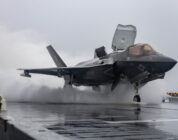Since the North Korean invasion of the South on June 25, 1950, United Nations forces had managed to reverse the situation by September, retaking the capital of Seoul and driving a routed Korean People’s Army (KPA) back into its home territory.
The newly established communist China, however, could not tolerate a united pro-Western Korea on its Manchurian border, and in late October, the so-called People’s Volunteer Army (PVA) intervened in the conflict, crossing the Yalu River into Korea.
By mid-November the PVA had thrown the U.N. forces back, retaking Seoul and giving the North Koreans a chance to regroup. In February 1951, however, the Chinese supply lines were overextended and recovering U.N. forces brought their offensive to a halt in the Battle of Chipyong-ni on Feb. 13-14 and Operation Killer nearly a week later.
On March 7, the U.N. launched another offensive, dubbed Operation Ripper, conceived by Gen. Matthew Ridgway to flank Seoul and destroy the PVA and KPA.
Ridgway achieved the first objective, with his troops advancing an average of 30 miles of frontage, flanking Seoul and encountering virtually no opposition as the South Korean capital changed hands for the fourth — and last — time on March 15.
By the declared conclusion of the offensive on March 23, the communist armies suffered thousands of casualties, but a well-executed fighting retreat kept them intact for the fighting yet to come — which for the next two years would see even greater casualties but no decisive battles on either side.
It was at the very beginning of Operation Ripper that Sfc. Nelson Brittin experienced the sort of savage hill fighting that became the norm for the rest of the Korean War.

Nelson Vogel Brittin was born in Audubon, New Jersey, on Oct. 31, 1920, and was drafted into the U.S. Army on July 7, 1942. Brittin served in Italy during World War II and discharged in 1946. He briefly attending the University of Florence, Italy, before deciding to reenlist in 1948, serving in the occupation forces in Japan.
He had risen in rank to sergeant first class when he was shipped to the Republic of Korea with I Company, 3rd Battalion, 19th Regiment, 24th Infantry Division. He was wounded in December 1950 and February 1951, but had returned to his unit in time for Operation Ripper.
On March 7, 1951, U.N. forces on either side of Seoul crossed the Han River, encountering small, often stubborn pockets of Chinese resistance whose sole purpose proved to be slowing down the U.N. offensive while the bulk of their armies withdrew northward to more defensible ground.
Near Yonggong-Ni that day, I Company crossed the Han and encountered a pocket of resistance in the form of fortified machine gun positions on a hill.
Brittin volunteered to lead a squad to secure the hill and due to the meager cover it afforded, he ordered his men to cover him while he moved up alone. He threw a grenade at the first enemy position he engaged, but the enemy returned it in kind with a grenade of their own, which knocked him down and wounded him.
Refusing medical attention, Brittin replenished his grenade supply, which he hurled at several enemy positions until their occupants abandoned them and he shot them as they fled. As he approached one defensive position, Brittin’s rifle jammed, but without hesitation he leaped into the hole and killed all its occupants using his bayonet and his rifle butt.
At that point, Brittin noticed one of his squads pinned down by an enemy machine gun, so he rushed it from behind, threw a grenade into it, then ran around to the front to kill the emerging three-man crew with his rifle.
As they resumed their climb, Brittin and his squad had not advanced 100 yards before coming under fire with what his citation described as a “camouflaged, sandbagged machine gun nest well-flanked by supporting riflemen.”
As his citation continued, “Brittin again charged this new position in an aggressive endeavor to silence this remaining obstacle and ran directly into a burst of automatic fire which killed him instantly. In his sustained and driving action, he had killed 20 enemy soldiers and destroyed four automatic weapons, the conspicuous valor, and noble self-sacrifice displayed by Sfc. Brittin enabled his inspired company to attain its objective.”
Brittin’s body was returned home in November 1951 and buried at Beverly National Cemetery in Beverly, New Jersey. On Jan. 16, 1952, his parents received a posthumously awarded Medal of Honor from then-Defense Secretary Robert Lovett. The roll on/roll off Military Sealift Command cargo ship ESB-4, built in 2002, is named Nelson V. Brittin in his honor.





